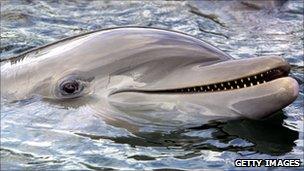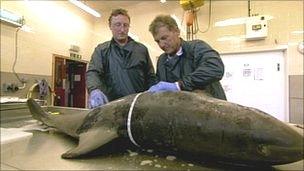Dolphin autopsy reveals deformity of spine
- Published
A dead dolphin washed up on one of Scotland's beaches was autopsied by a veterinary team and BBC presenter and diving expert Paul Rose. He describes the fascinating, if somewhat gory business of an open-air post-mortem.
"If killed by an attack, the dolphin would have multiple internal injuries including bruising around the head and thorax, skeletal injuries including broken ribs and spine.
"Broken ribs can lead to punctured lungs. Ruptured liver and lungs can be the cause of death, if not it is often a combination of shock and respiratory difficulty from the damaged lungs."
Andrew Brownlow is the veterinary investigations officer, at the Scottish Agricultural College (SAC).
Each year approximately 160 whales, seals, porpoises and dolphins are washed up on Scottish beaches, and it falls to the dedicated team at the SAC to investigate how and why they have died.
He said: "We try to find out why they died in case there are any diseases or pollution we should be aware of. It also helps increase our knowledge of these animals to make it easier to identify any potential threats to these creatures.
"Large whales have to be autopsied on the beach as it is almost impossible to transport them and the team have to work fast as whales can spontaneously explode as they decompose. Smaller mammals, like the emasculated bottlenose dolphin on my bench, are taken into the laboratory for a comprehensive post-mortem."
Andrew had prepared me well for this gory work and I was wearing full waterproofs, Wellington boots and two sets of gloves including a knife-proof one for my left hand.
He quickly identified the dolphin as a young male bottlenose dolphin, found dead on a beach near Aberdeen.
Initial observations including weight (60kgs) and length (65cm) were recorded and we noted that the dolphin had some signs of a relatively harmless pox on his back along with scarring at the base of his fin.
His flippers and sides had sets of regular scratch scars, like small rake marks which puzzled me.
"There is some old damage, rows of parallel scars over a bruise, these are consistent with past dolphin attacks, it's their teeth marks," said Andrew, who lined up a dolphin jaw to the scratches.
We could see that these were dolphin tooth marks - apparently a sign of quite normal behaviour.

Bottlenose dolphins can seriously injure or even kill each other in attacks
The birds had been quick to take advantage of the corpse on the beach and we could see plenty of evidence of their pecking at the skin.
I was admiring the beautiful, iconic curve of the dolphin's back when Andrew pointed out that dolphins only maintain this shape when they are alive.
I felt along the spine and it was clear that it was indeed bent.
My scalpel cut easily through the thick blubber and I removed a large slab from his left side to reveal the innermost wonders.
As we delved deeper, Andrew held up the windpipe and lungs to point out that the lungs told the story of how the calf had been laying on his right side, as the right lung was heavy and squashed.
We celebrated the dolphin's ability to dive deep by measuring its chest capacity compared to mine, and I was surprised to learn that dolphins' two kidneys have the capacity of a thousand human kidneys so that they can process sea water.
The heart and liver looked huge to me, and as we examined and removed the organs Andrew pronounced them all to be apparently normal.
I then ran my hands across the ribs to check for any damage and with nothing unusual to record we used big industrial shears to cut the ribs from the backbone.
We kept at it, and I removed everything that Andrew would let me and quite understandably, he tackled the more delicate sections such as the adrenal glands (normal and not swollen which would indicate high levels of stress), the testes, the spleen and the removal of the head.
Aside from a lurking smell of death in the background there were really no extra unpleasant smells to contend with. There was a lot of blood of course, but we washed this easily down the drain on my bench.
Finally we could clearly see the spine. It had a massive deformity, almost a U-bend, beginning just behind his fin. It was this bend that had given our dolphin what appeared to be a "normal swimming" look.
"These deformities are common in young dolphins from the Moray Firth," said Andrew.
Andrew formed a hypothesis that put the little dolphin's short life into perspective.
The spinal deformity he was born with was no hindrance at all while he was swimming and feeding from his mother.
The veterinarian said: "From this initial examination it looks like the damage caused to the dolphin calf's spine prevented it from being able to go under the water.
"The lack of subcutaneous fat, the fat under the skin, and fat around the organs means the dolphin wasn't feeding, probably due to its damaged back."
So when it came time to fend for himself, the calf just could not keep up the pace and fell behind the pod.

The team found the dolphin was not feeding properly
When he was washed up he was alive, but had died after some time on the beach.
This looks to be a tough outcome, but his early demise could have been much tougher, as it is not uncommon for young dolphins to be repeatedly attacked by adults.
A group of male dolphins work at separating the calf from its mother, then ram it and hold it underwater.
"There are a few ideas from pollution causing developmental defects affecting their spines to attacks by other dolphins. These attacks are associated with dolphin infanticide.
"The reasons are not completely understood, it could be by females when there is food pressure or males to increase their chance of breeding as the females can mate again after only a few days once their calf has died.
"It's a complex issue and can have a big effect on small populations of cetaceans."
This behaviour seems a long way from the smiling, companionable and heroic friends who come and join us at sea, playing in boats' bow waves.
Britain's Secret Seas begins with a programme on the Giants of the West on Sunday 8 May, on BBC Two at 2000 BST, continuing over four Sundays.
- Published5 May 2011
- Published4 March 2011